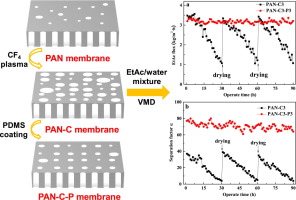Separation and Purification Technology ( IF 8.6 ) Pub Date : 2018-01-06 , DOI: 10.1016/j.seppur.2018.01.011 Huanhuan Wu , Fei Shen , Yi Su , Xiangrong Chen , Yinhua Wan

|
For the recovery of ethyl acetate (EtAc) from aqueous solution via vacuum membrane distillation (VMD), hydrophobic porous membranes with high and stable separation performance were prepared by carbon tetrafluoride (CF4) plasma treatment on polyacrylonitrile (PAN) membrane followed by polydimethylsiloxane (PDMS) coating. The effects of plasma treatment conditions and PDMS contents on the morphology, surface porosity and separation performance of modified membranes were investigated. It was found that both the two modification operations increased the hydrophobicity of the PAN membrane. CF4 plasma treatment increased the hydrophobicity (the contact angle increased from 42° to 124° measured by 2.5 wt% EtAc solution), surface mean pore size (from 24.6 nm to 150.5 nm) and porosity (from 7% to 32.3%) of hydrophilic PAN membrane, suggesting that the CF4-modified membranes (PAN-C membranes) with high hydrophobicity could be used in VMD. Optimized PDMS coating on the PAN-C membranes (PAN-C-P membranes) further narrowed the pore size distribution but retained porous and hydrophobic surface. The PAN-C membranes were much less efficient and stable in separating EtAc from water comparing with the PAN-C-P ones. For instance, for the separation of 1 wt% EtAc/water mixture, the best VMD performance in this work was achieved by the PAN-C3-P3 membrane with a separation factor of 70 and a total flux of 7.85 kg/m2 h (PSI = 542). Moreover, the PAN-C3-P3 membrane showed a very stable separation performance than that of the PAN-C3 membrane during a 90 h intermittent VMD operation, indicating a very promising application prospect for EtAc recycling.
中文翻译:

通过等离子处理改性聚丙烯腈膜,然后通过聚二甲基硅氧烷涂层通过真空膜蒸馏从水溶液中回收乙酸乙酯
为了通过真空膜蒸馏(VMD)从水溶液中回收乙酸乙酯(EtAc),通过在聚丙烯腈(PAN)膜上进行四氟化碳(CF 4)等离子体处理,然后使用聚二甲基硅氧烷( PDMS)涂层。研究了等离子体处理条件和PDMS含量对改性膜的形貌,表面孔隙率和分离性能的影响。发现两种修饰操作均增加了PAN膜的疏水性。CF 4等离子体处理增加了亲水性PAN的疏水性(用2.5 wt%的EtAc溶液测得的接触角从42°增至124°),表面平均孔径(从24.6 nm增至150.5 nm)和孔隙率(从7%增至32.3%)膜,这表明具有高疏水性的CF 4改性膜(PAN-C膜)可用于VMD。PAN-C膜(PAN-CP膜)上经过优化的PDMS涂层进一步缩小了孔径分布,但保留了多孔且疏水的表面。与PAN-CP膜相比,PAN-C膜从水中分离EtAc的效率和稳定性要低得多。例如,对于分离1 wt%的EtAc /水混合物,PAN-C3-P3膜具有70的分离系数和7.85 kg / m的总通量,从而获得了这项工作中最佳的VMD性能。2 小时(PSI = 542)。此外,在90小时的间歇式VMD操作过程中,PAN-C3-P3膜显示出比PAN-C3膜非常稳定的分离性能,这表明EtAc回收的应用前景非常广阔。


























 京公网安备 11010802027423号
京公网安备 11010802027423号